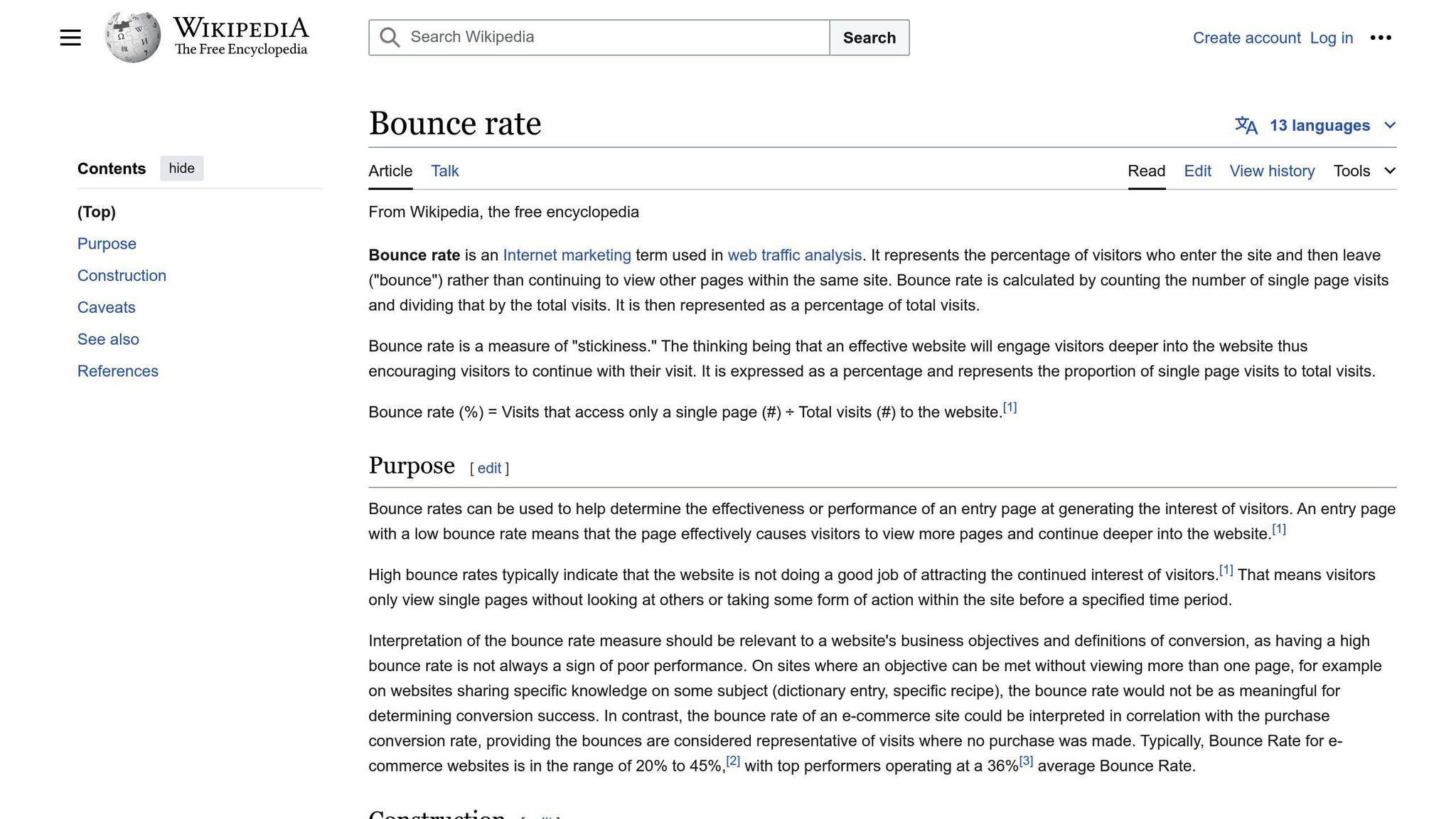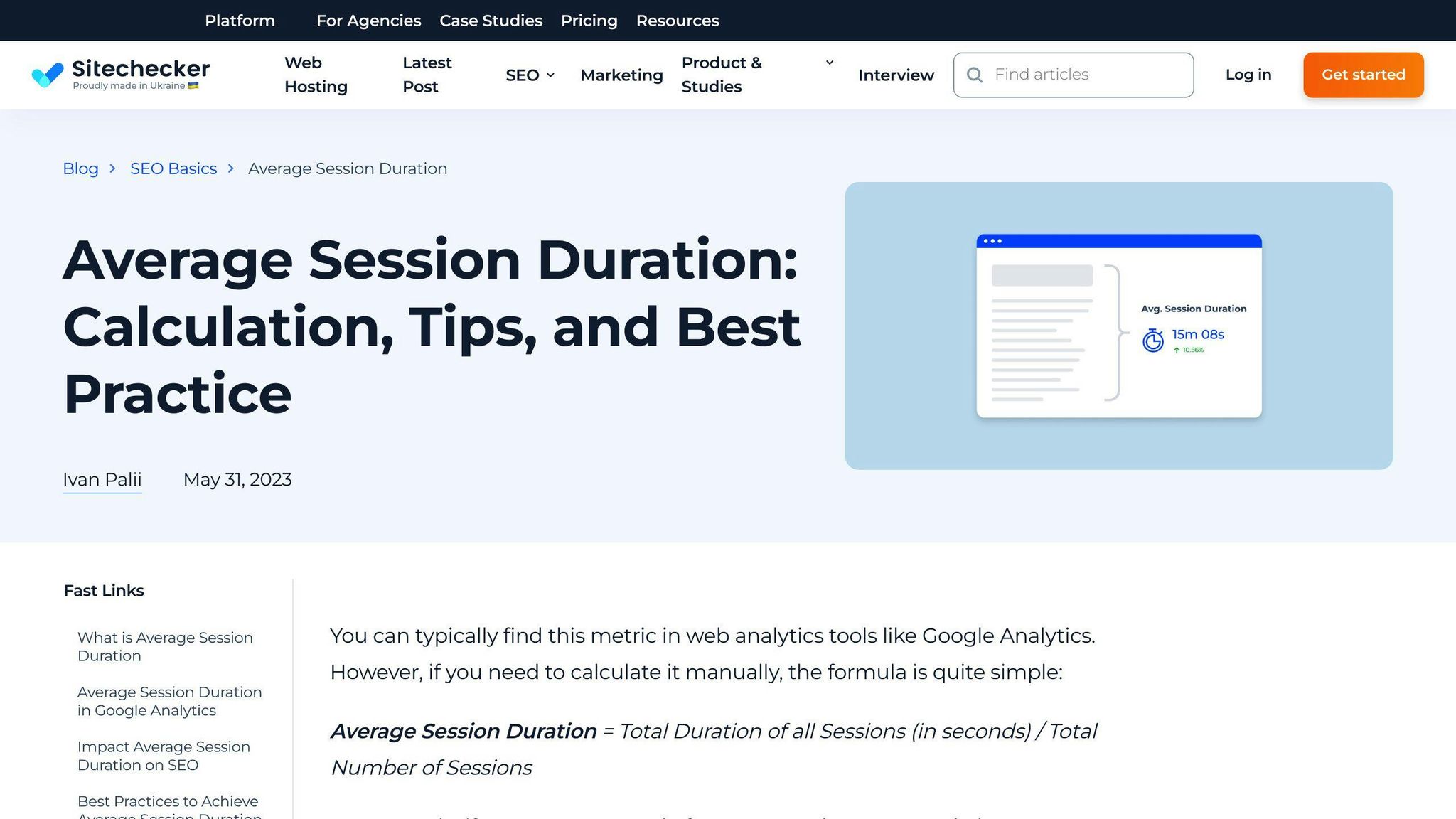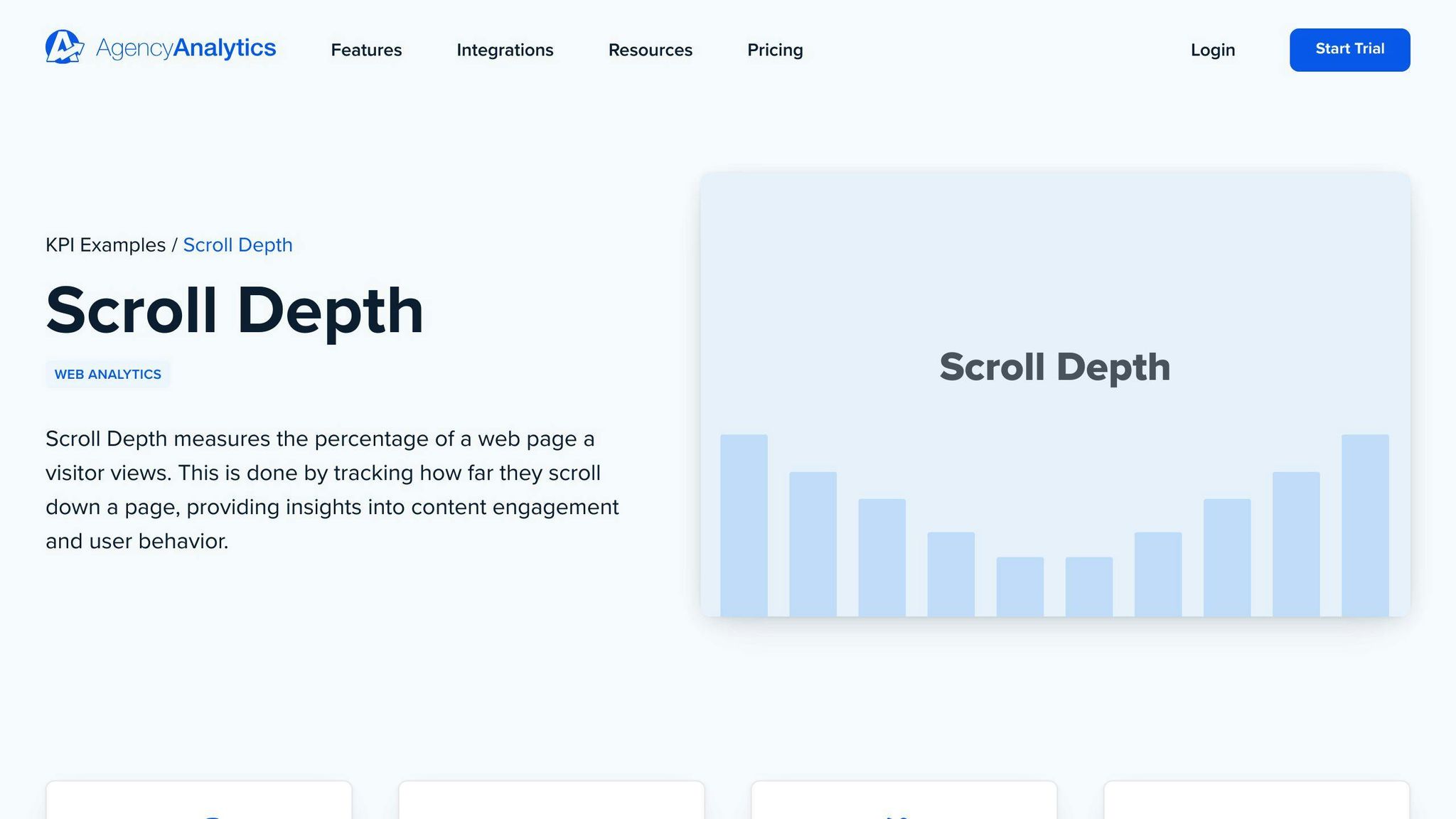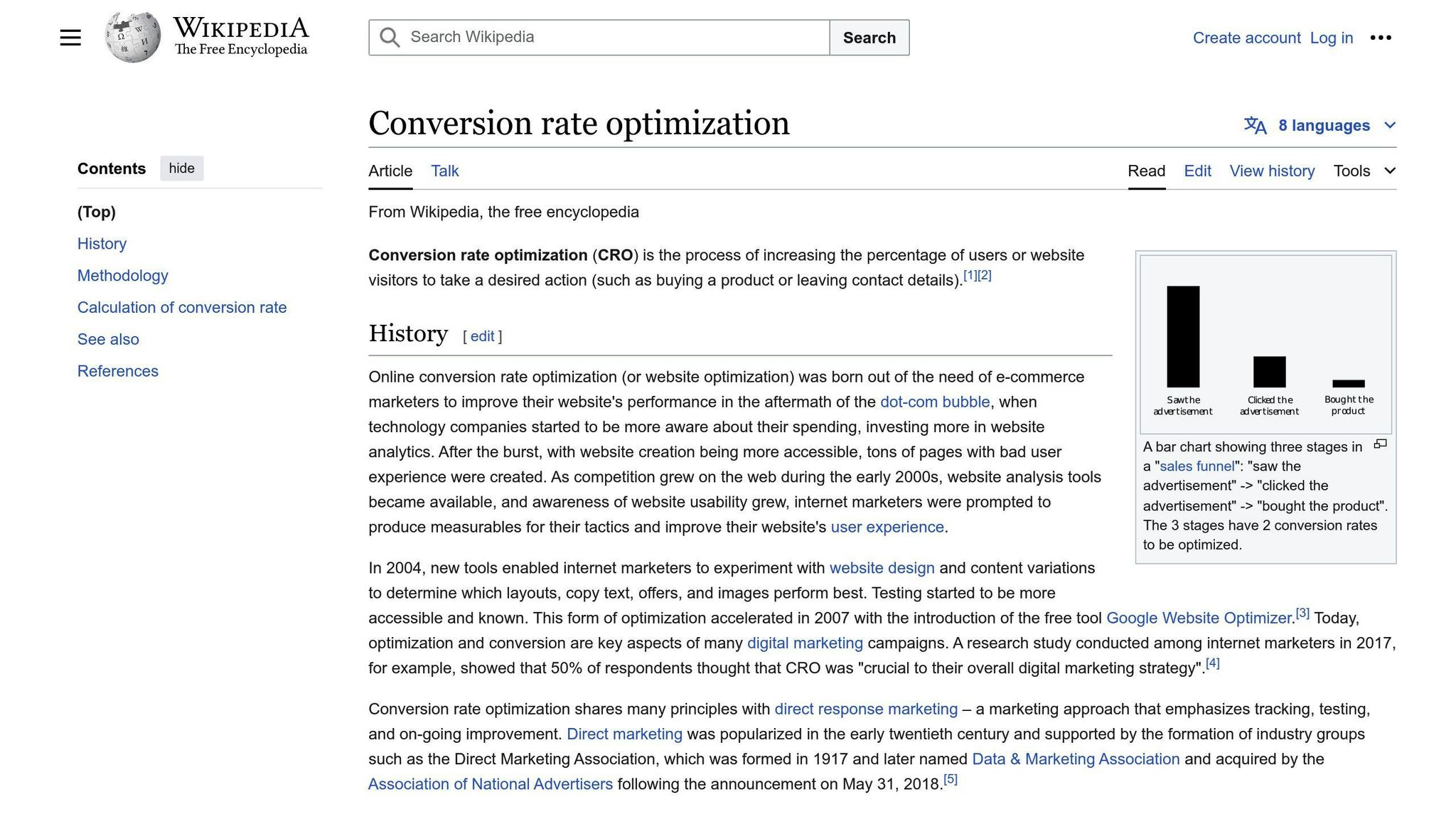User engagement metrics measure how users interact with a website and indicate its quality, relevance, and authority for search engines. Improving these metrics can boost your SEO performance:
- Click-Through Rate (CTR): Percentage of users who click on a link or call-to-action
- Bounce Rate: Percentage of visitors who leave after viewing only one page
- Dwell Time: How long users stay on your site after clicking a search result
- Pages Per Session: Average number of pages viewed per visit
- Average Session Duration: Average time users spend on your site per visit
- Scroll Depth: How far down a page users scroll
- Conversion Rate: Percentage of visitors who complete a desired action (purchase, sign-up, etc.)
To optimize these metrics and improve your SEO:
| Metric | Key Strategies |
|---|---|
| Click-Through Rate | Optimize meta titles and descriptions, use effective ad copy, target the right audience |
| Bounce Rate | Improve website speed, enhance user experience, use clear and relevant content |
| Dwell Time | Create high-quality content, optimize page speed, improve user experience |
| Pages Per Session | Create engaging content, improve navigation, optimize for mobile, use internal links |
| Session Duration | Create high-quality content, improve usability, personalize user experience, optimize for mobile |
| Scroll Depth | Use attention-grabbing headlines and visuals, optimize content layout, improve performance |
| Conversion Rate | Refine ad targeting, enhance site usability, test calls-to-action, use analytics tools |
By understanding and optimizing these user engagement metrics, you can provide a better user experience, increase conversions, and drive higher search engine rankings.
Related video from YouTube
1. Click-Through Rate (CTR)
Definition
Click-through rate (CTR) is the percentage of people who click on a link or call-to-action (CTA) after seeing it. It shows how well your content attracts users to take the desired action.
Explanation
CTR is an important user engagement metric because it indicates if your content interests your target audience. A high CTR means your content is relevant and appealing, leading to more conversions and better SEO. A low CTR suggests your content needs improvement or your targeting is off.
For SEO, CTR influences search engine rankings. Search engines like Google consider CTR when determining a website's relevance and authority. A website with a high CTR is likely seen as more relevant and authoritative, resulting in higher rankings and visibility.
Tips/Strategies
To improve your CTR:
- Optimize meta titles and descriptions: Write clear, keyword-rich meta titles and descriptions to encourage users to click your search result.
- Use effective ad copy: Create ad copy that resonates with your target audience and prompts action.
- Target the right audience: Ensure your content targets the right audience to increase the likelihood of clicks.
- Use eye-catching visuals: Incorporate high-quality, relevant visuals to make your content stand out and attract clicks.
- Test and refine: Continuously test and refine your content, ads, and targeting to optimize CTR and user engagement.
2. Bounce Rate

Definition
Bounce rate is the percentage of visitors who leave a website after viewing only one page, without taking any further action.
Explanation
A high bounce rate indicates that users are not finding what they need on your website. This could be due to poor content, confusing design, or a bad user experience. Search engines like Google consider bounce rate when ranking websites. A high bounce rate can negatively impact your search rankings, as it suggests your website is not relevant or useful to users.
Tips/Strategies
To reduce your bounce rate:
- Improve website speed: A slow website can drive users away. Ensure your website loads quickly.
- Enhance user experience: Make your website easy to navigate and understand, with clear content and design.
- Use simple, relevant content: Avoid cluttered or confusing text. Use clear headings, short paragraphs, and relevant visuals.
- Add internal links: Guide users to other relevant pages on your website to encourage further exploration.
- Test and refine: Continuously test and improve your website's design, content, and user experience to reduce bounce rate.
| Bounce Rate Issue | Solution |
|---|---|
| Slow website speed | Optimize website performance |
| Poor user experience | Improve design and navigation |
| Irrelevant or confusing content | Use clear, concise, and relevant content |
| Lack of internal linking | Add links to related pages |
| Outdated or untested design | Regularly test and refine the website |
3. Dwell Time

Definition
Dwell time is how long a user stays on your website after clicking a link from the search engine results page (SERP) before going back to the SERP.
Explanation
Dwell time shows if users find your content engaging. A longer dwell time indicates that users are interested in your content, which sends positive signals to search engines like Google. This can improve your search rankings.
Tips/Strategies
To increase dwell time:
- Create high-quality content: Make your content informative, well-researched, and easy to read.
- Optimize page speed: Ensure your website loads quickly to keep users from leaving.
- Improve user experience: Design your website to be easy to navigate and understand.
- Use internal links: Link to other relevant pages on your site to encourage further exploration.
- Test and refine: Continuously test and improve your website's design, content, and user experience.
| Issue | Solution |
|---|---|
| Slow page loading | Optimize website performance |
| Poor navigation | Improve website design and layout |
| Confusing content | Use clear, concise language |
| Lack of internal links | Add links to related pages |
| Outdated design | Regularly test and update the website |
sbb-itb-b8bc310
4. Pages Per Session

Definition
Pages per session measures the average number of pages a user views during a single visit to your website.
Explanation
A higher pages per session value means users find your content engaging and relevant. This positive user behavior sends good signals to search engines, which can lead to better rankings.
Tips/Strategies
To increase pages per session:
- Create engaging content: Use internal links to guide users to related content. Optimize your site's navigation for easy browsing. Add calls-to-action (CTAs) that direct users to other valuable pages.
- Improve site navigation: Make it easy for users to find and access the content they want.
- Optimize for mobile: Ensure a seamless experience across devices to encourage users to explore more pages.
- Use internal linking: Link to related articles or products from within your content.
- Streamline navigation: Help visitors find information quickly to increase the chances of them viewing more pages.
| Issue | Solution |
|---|---|
| Confusing navigation | Improve website layout and menus |
| Lack of internal links | Add links to related content |
| Poor mobile experience | Optimize for mobile devices |
| Unengaging content | Create high-quality, relevant content |
| Cluttered pages | Simplify design and layout |
5. Average Session Duration

Definition
Average session duration measures how long users spend on your website in a single visit.
Explanation
A longer average session duration shows that users find your content engaging and relevant. This positive user behavior sends good signals to search engines, which can improve your website's rankings.
Tips/Strategies
To increase average session duration:
- Create high-quality content: Engage users with informative, well-structured, and visually appealing content.
- Improve website usability: Ensure easy navigation, fast page loading, and a smooth user experience.
- Personalize user experience: Tailor content to individual users' interests and needs to keep them engaged.
- Optimize for mobile: Ensure a seamless experience across devices to encourage users to explore more.
- Use internal linking: Link to related content to guide users through your website.
| Issue | Solution |
|---|---|
| Unengaging content | Create high-quality, relevant content |
| Poor navigation | Improve website layout and menus |
| Slow page loading | Optimize website performance |
| Lack of personalization | Tailor content to user interests |
| Poor mobile experience | Optimize for mobile devices |
| Lack of internal links | Add links to related content |
6. Scroll Depth

Definition
Scroll depth shows how far down a webpage a user scrolls. It's usually shown as a percentage of the page's content. This metric helps you understand if your content engages and interests users.
Explanation
Scroll depth is an important user engagement metric. It shows if users find your content relevant and useful, which can positively impact your search engine rankings. A higher scroll depth means users are consuming your content and interacting with your website. A lower scroll depth suggests users may be abandoning your content.
Tips/Strategies
To improve scroll depth:
- Create engaging content: Use attention-grabbing headlines, short paragraphs, and relevant images to keep users interested.
- Optimize content layout: Use a clear layout to guide users through your content.
- Use internal links: Link to related content to encourage users to explore more.
- Improve website performance: Ensure fast page loading and smooth navigation to reduce bounce rates.
- Conduct A/B testing: Test different content layouts, headlines, and images to see what works best for your audience.
| Issue | Solution |
|---|---|
| Unengaging content | Use attention-grabbing headlines, short paragraphs, and relevant images |
| Poor content layout | Optimize layout to guide users through content |
| Lack of internal links | Add links to related content |
| Slow website performance | Ensure fast page loading and smooth navigation |
| Untested content | Conduct A/B testing to identify what works best |
7. Conversion Rate

Definition
Conversion rate shows the percentage of website visitors who complete a desired action, like filling out a form, making a purchase, or signing up for a newsletter.
Explanation
Conversion rate is a key user engagement metric that directly impacts your website's success. A high conversion rate means your website is effective at persuading visitors to take the desired action. A low conversion rate may indicate issues with your website's user experience, content, or design.
Tips/Strategies
To improve conversion rate:
- Refine ad targeting and creative: Attract more qualified traffic by refining your ad targeting and creative to match your ideal customer.
- Enhance site usability and navigation: Make it easy for visitors to find what they need and complete the desired action by improving usability and navigation.
- Test and update calls to action (CTAs): Ensure your CTAs are clear and compelling by testing different versions and updating them regularly.
- Use analytics and heat mapping tools: Gain insights into user behavior and identify barriers to conversion using analytics and heat mapping tools.
- Optimize for mobile users: Ensure your website is mobile-friendly and provides a seamless experience across all devices.
| Issue | Solution |
|---|---|
| Unqualified traffic | Refine ad targeting and creative |
| Poor usability and navigation | Enhance site usability and navigation |
| Unclear or ineffective CTAs | Test and update calls to action |
| Lack of user behavior insights | Use analytics and heat mapping tools |
| Poor mobile experience | Optimize for mobile users |
Wrapping Up
In this article, we looked at the importance of user engagement metrics for SEO. We discussed seven key metrics that can help boost your website's search engine rankings:
- Click-Through Rate (CTR): The percentage of people who click on a link or call-to-action after seeing it.
- Bounce Rate: The percentage of visitors who leave your website after viewing only one page.
- Dwell Time: How long a user stays on your website after clicking a link from the search engine results page before going back.
- Pages Per Session: The average number of pages a user views during a single visit to your website.
- Average Session Duration: How long users spend on your website in a single visit.
- Scroll Depth: How far down a webpage a user scrolls.
- Conversion Rate: The percentage of website visitors who complete a desired action, like filling out a form or making a purchase.
By understanding and improving these metrics, you can:
- Provide a better user experience
- Increase conversions
- Drive higher search engine rankings
Here are some tips to optimize these metrics:
Improve Click-Through Rate (CTR)
- Optimize meta titles and descriptions
- Use effective ad copy
- Target the right audience
- Use eye-catching visuals
- Test and refine your content
Reduce Bounce Rate
| Issue | Solution |
|---|---|
| Slow website speed | Optimize website performance |
| Poor user experience | Improve design and navigation |
| Irrelevant or confusing content | Use clear, concise, and relevant content |
| Lack of internal linking | Add links to related pages |
| Outdated or untested design | Regularly test and refine the website |
Increase Dwell Time
| Issue | Solution |
|---|---|
| Slow page loading | Optimize website performance |
| Poor navigation | Improve website design and layout |
| Confusing content | Use clear, concise language |
| Lack of internal links | Add links to related pages |
| Outdated design | Regularly test and update the website |
Increase Pages Per Session
| Issue | Solution |
|---|---|
| Confusing navigation | Improve website layout and menus |
| Lack of internal links | Add links to related content |
| Poor mobile experience | Optimize for mobile devices |
| Unengaging content | Create high-quality, relevant content |
| Cluttered pages | Simplify design and layout |
Increase Average Session Duration
| Issue | Solution |
|---|---|
| Unengaging content | Create high-quality, relevant content |
| Poor navigation | Improve website layout and menus |
| Slow page loading | Optimize website performance |
| Lack of personalization | Tailor content to user interests |
| Poor mobile experience | Optimize for mobile devices |
| Lack of internal links | Add links to related content |
Improve Scroll Depth
| Issue | Solution |
|---|---|
| Unengaging content | Use attention-grabbing headlines, short paragraphs, and relevant images |
| Poor content layout | Optimize layout to guide users through content |
| Lack of internal links | Add links to related content |
| Slow website performance | Ensure fast page loading and smooth navigation |
| Untested content | Conduct A/B testing to identify what works best |
Increase Conversion Rate
| Issue | Solution |
|---|---|
| Unqualified traffic | Refine ad targeting and creative |
| Poor usability and navigation | Enhance site usability and navigation |
| Unclear or ineffective CTAs | Test and update calls to action |
| Lack of user behavior insights | Use analytics and heat mapping tools |
| Poor mobile experience | Optimize for mobile users |
Take action today by implementing these tips and strategies. Monitor your user engagement metrics regularly, identify areas for improvement, and optimize your website. With time and effort, you can boost your website's performance and achieve your SEO goals.